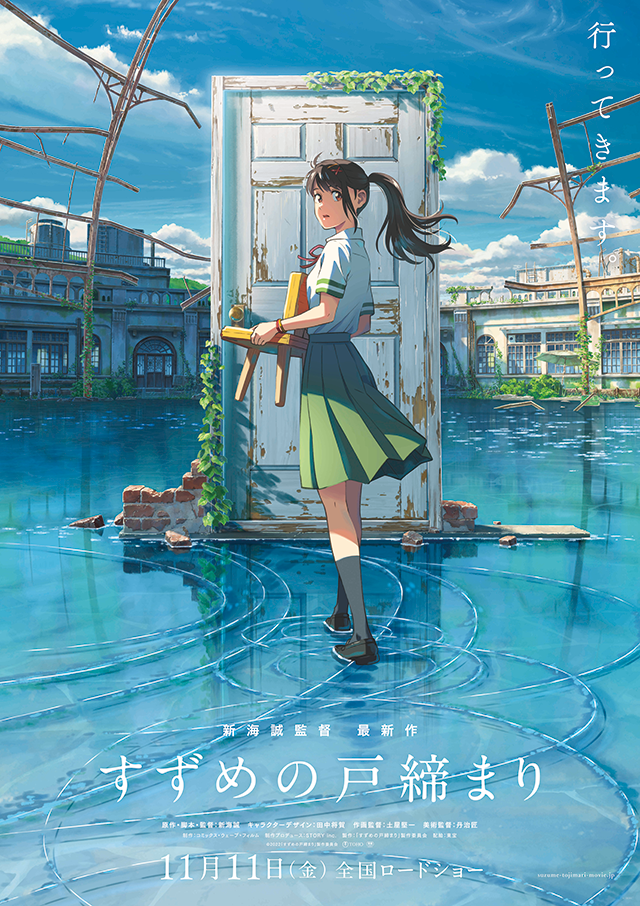The trailer for Suzume, the latest film from director Makoto Shinkai, looked frankly silly. It sold the story as a sort of Princess and the Frog retelling where the love interest has been transformed into a kid’s chair, with maybe some fantasy fighting on the side. I’ll admit that this description blindsided me, but the trailer’s ridiculous story forms only a part of the movie. As a whole, it far surpassed my expectations, proving to be thrilling, touching, and genuinely comedic.
In the world of Suzume, doors to the Ever-After—the realm of dead souls—sometimes appear in abandoned places. If monsters like the terrifyingly animated Worm come through these doors, they wreak havoc in the form of devastating earthquakes. One day, a mysterious stranger named Sota visits Suzume’s hometown to close one of these doors. While following Sota around, Suzume inadvertently frees a guardian deity tasked with keeping the doors closed. The guardian escapes and, to ensure that Sota cannot return it to its post, turns him into a chair. Suzume sets off to help chase down the escaped guardian and convince it to change Sota back to his human form. Along the way, she and Sota must also close the doors to the Ever-After, which stand open all over Japan.

The movie is a road-trip rom-com for a good portion of its runtime, as the trailer suggests. Fortunately, it knows how silly the chair situation is and doesn’t use it to try and pull off romantic or emotional scenes. Regardless, this is no airy chick-flick. The comedy elements do not dominate; instead, they function as a reprieve from the movie’s heavier themes. For instance, it isn’t clear from the trailer that these charming chair-related mishaps will be intercut with extremely high-stakes fight scenes as Suzume and Sota struggle to stop the Worm from coming through the doors to the Ever-After. The film implies that they are trying to avoid a repeat of the 2011 Tohoku earthquake and tsunami, which devastated Japan and left thousands dead. Several open gates are located in areas abandoned after the disaster, such as a village struck by the tsunami or the land contaminated by fallout from the Fukushima nuclear breach. Suzume and Sota close these doors, thwarting the Worm’s ability to trigger more earthquakes by invoking the memory of the people who used to frequent these places—a powerful tribute to the victims of natural disasters. Suzume’s personal history, too, is closely linked with Tohoku, which gradually becomes clear over the course of the story. The decision to initially withhold this information from the viewer is a strange one given how central the disaster is to the film. Her mission to close the doors and prevent earthquakes would have been much more meaningful with the knowledge of what these disasters have cost her in the past.
A lazy reviewer might compare any fantasy anime with the films of Hayao Miyazaki, the creative force behind Studio Ghibli. Since Ghibli films have done well in North America, they get roped into North American discussions of anime, whether or not it makes sense to do so. However, Makoto Shinkai explicitly invites the comparison with his nods to Ghibli films like Kiki’s Delivery Service (1989) and Whisper of the Heart (1995). I will oblige Shinkai and note that both directors have a gorgeous animation style that is hyperrealistic at times when visual detail would heighten a scene’s impact. However, if Ghibli films are enamoured with the countryside, Suzume extends that love to the city, devoting many frames to carefully drawn scenes of Tokyo. The focus on the urban setting is not just for immersion’s sake but to help communicate the gravity of an attack by the Worm, which would destroy the entire city. The Worm itself recalls the demons of Princess Mononoke (1997) in its terrifying organicity. From the first shot of the Worm, all my doubts about the film were replaced with a morbid fascination that glued me to my seat. Suzume also benefits from a fascination with the night sky that is all Shinkai’s own; the sky of the Ever-After, lush with stars, is as striking as the comet in his 2016 film Your Name. All these things make Suzume a visual treat in addition to helping sell its world.
The film’s weakest point is its time travel plotline, which could be removed without affecting its narrative or emotional arcs. It doesn’t come into play until a third-act twist, so it doesn’t offer the catharsis of a mystery solved. Instead, it commits the cardinal sin of time travel narratives by assuming that things automatically become meaningful when brought full circle. The scene where one of the characters encounters their younger self is meant to send a message of resilience and hope, but that message falls flat because the encounter never seems to have an impact on either the past or the present.
The bungled time travel plot is, however, one of the very few sour notes in an otherwise entertaining and moving film. Don’t be deterred by the image of a girl kissing a chair as I was—Suzume has much more depth than its marketing gives it credit for.
